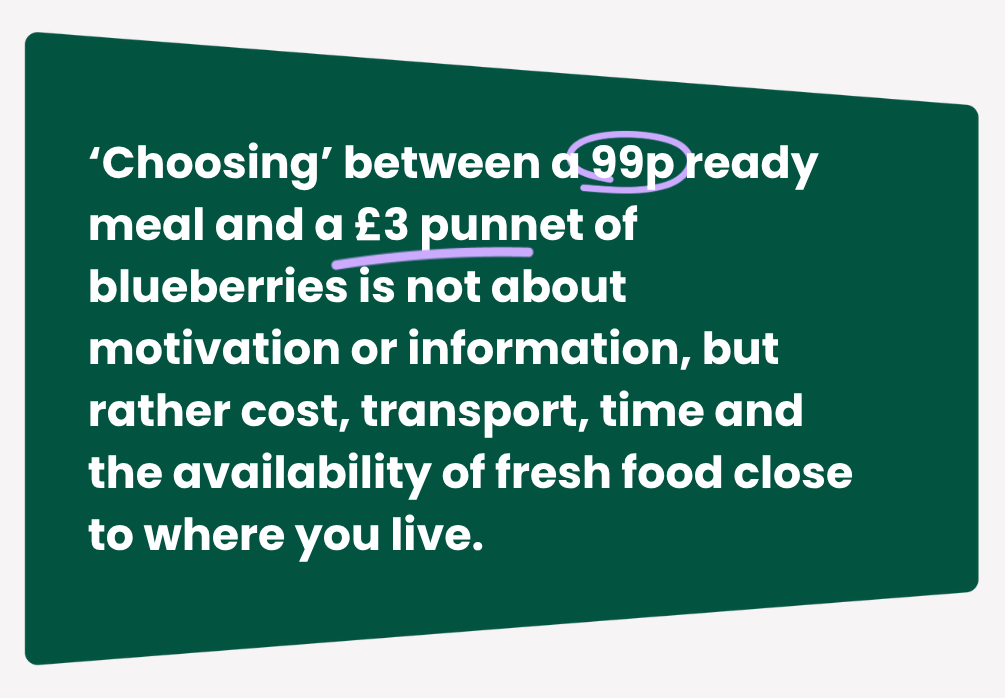Last week, the government set out proposals to use ‘nudges’ as part of a preventative health strategy to encourage healthy eating. At DG Cities, our Behavioural Innovation practice also draws on behavioural science to tackle council challenges, from fly tipping to active travel, in collaboration with local communities. Explaining the value of a more systems-based approach to behavioural science in public policy, Director of Research & Insights, Ed Houghton examines the latest plans.
At first glance, the government’s latest proposal to encourage healthier eating habits through ‘nudges’ sounds sensible. Ministers are suggesting supermarkets promote fruit and veg through loyalty points, in-store promotions and by improving aisle and display layouts.
Helping people eat more healthily is a vital policy goal and behavioural science has much to offer in terms of finding new, effective solutions. The problem is, this idea isn’t new, or particularly effective on its own – and in many ways it could do more harm than good to the government’s aspirations for an NHS fit for the future.
We all want to be healthier… don’t we?
Healthy communities and neighbourhoods are all part of the Government’s drive to set the foundation for a reformed NHS. It’s about taking health out into communities, and enabling other parts of the system – like supermarkets and schools – to play a role in public health, which is a sound strategy to move us towards a more preventative approach to medicine. It’s an idea that’s clearly having its time in the sun too: the NHS 2019 long-term plan prioritised integrated care and population health management, but the recent call for a “neighbourhood health service” represents an even greater gear change.
However… the problem with nudges is that they put the onus on individual choice and assume eating your five a day is just a matter of individual willpower or better information (rather than acknowledging the structural and social barriers that shape people's choices).
Our work with public health teams and the NHS has highlighted how access to affordable, nutritious food isn’t simply about the visibility of healthy options. Lower-income families are often confronted with difficult trade-offs between cost and nutritional value – “choosing” between a 99p ready meal and a £3 punnet of blueberries is not about motivation or information, but rather cost, transport, time and the availability of fresh food close to where you live.
In this context, small nudges at the point of sale may help in the short term, but they’re unlikely to deliver the sustained dietary improvements that policy-makers hope to achieve. Evidence supports this: tactics like product placement and loyalty rewards can modestly increase the purchase of healthier items, yet these changes rarely lead to long-term shifts in diet quality or health outcomes. A bit like going to the gym – there simply aren’t short-term fixes.
In our view, we need an approach that works across different systems, that combines behaviourally-informed initiatives with policies that address barriers to preventative medicine. For example, subsidies for fresh food, particularly in lower-income areas, could ease pressure on shoppers and retailers. Crucially, these kinds of interventions can improve access without harming viability for businesses – an important consideration if implementation is left to supermarkets themselves.
It takes a village…
Systemic approaches rely on collaboration between institutions, communities and individuals. There are lots of ways councils can help, from operational support for local produce markets to convening networks, and improving planning policy. Last year’s reforms to the National Planning Policy Framework were designed to support healthier eating by encouraging local authorities to consider health and wellbeing in planning decisions. This can mean supporting access to healthier food outlets and restricting the concentration of fast-food takeaways, particularly near schools.
We also see great potential in locally-driven, community-led food initiatives, like neighbourhood food hubs or cooking classes. In Greenwich, Food On Our Doorstep (FOOD) clubs provide good-quality food at a low cost to local communities, in partnership between the council and Family Action. A free cooking club in Thamesmead helps residents find ways to use produce. Another voluntary scheme for food businesses by Greenwich Cooperative Development Agency helps fast food outlets or cafés make simple and affordable changes.
Similarly, the Heal-D programme, founded in 2016 by Prof Louise Goff of the University of Leicester, aims to target type 2 diabetes in black African and Caribbean adults by sharing knowledge on how to cook popular dishes in more healthy ways. Evidence shows that these methods are more powerful because they’re built with the people they’re intended to support. These kinds of initiatives respect people’s autonomy and choice, build trust and reflect the realities of the way we all live. Models such as ‘boosts’ and ‘self-nudges’, which help individuals develop long-term skills and strategies, offer promising alternatives to top-down loyalty schemes.
Rethinking blame
Just as important is the way we talk about food. Public messaging that emphasises ‘better’ choices can unintentionally put the blame on individuals, when in fact many supposedly ‘poor’ food decisions are rational responses to systemic barriers like time poverty or a lack of affordable options. Framing food as a collective issue can help to shift the narrative from personal responsibility to what can be done as a community. And in a changing climate this will only become more important as the food system is increasingly fraught by disruption and instability: producers, distributors and wholesalers will all need to work more closely to help ensure healthy food is our plates.
This means being more thoughtful about how we define ‘healthy’ food too. Oversimplified labels, like apple = good, crisps = bad don’t always reflect the complexities of nutrition and can alienate people with diverse needs, including those with eating disorders. A balanced diet looks different for everyone, and we should support a broader understanding of nutrition, grounded in evidence.
We think there’s huge potential in more systemic approaches to policy design and intervention delivery that can help people make more informed decisions. Delivered effectively, they can help change systems and make a long-term difference to people’s lives. By working across sectors, listening to and acting on community needs and focusing on access and affordability as much as choice, we can design food environments that genuinely support health and wellbeing for all.
If you’re interested to find out more about our Behavioural Innovation work, read on here - or if you’re a council team, why not request one of our great free workshops for more specific insights.







